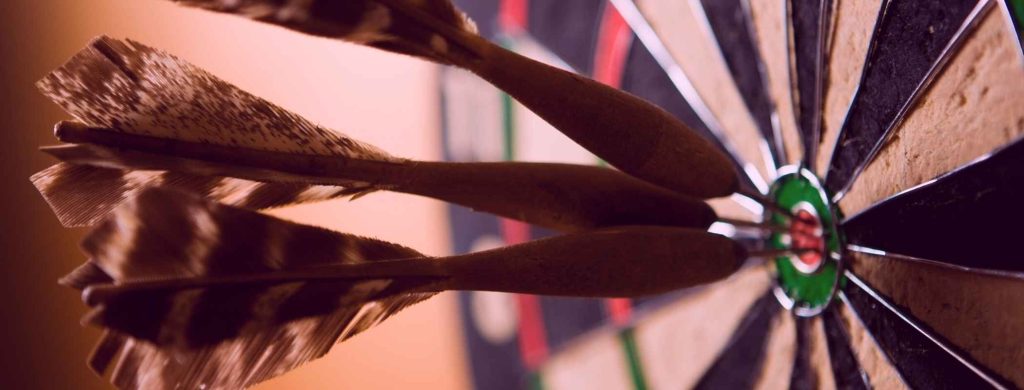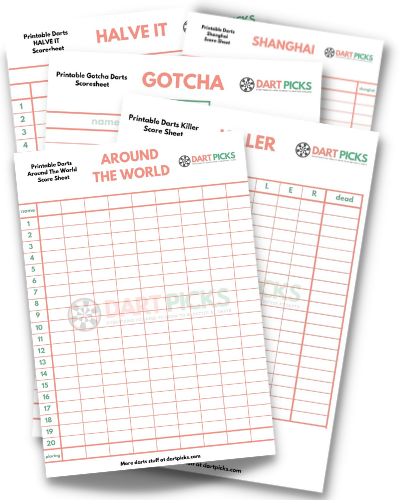Every darts player wants to win the game they’re playing. But to do so, they need to be well-practiced and have a good strategy. Up to 10% of a winning game is strategy, so having a few tricks up your sleeve is a must.
Here we share some of the best darts tactics with you. These tactics will improve how you play darts and may even secure a win.
Table of Contents
Stick With the Number You’re Good At
Following on from the above, it’s assumed that all darts players should aim for 20. But what if you’re not very good at hitting 20?
The simple solution to this problem is not to try to. If you’re much better at successfully aiming your darts at 18 or 19, for example, stick with them.
A good 3-dart average for non-professional players is between 60 and 80. As long as you’re scoring within this range, you’re considered a good player.
Stick to the Left-Hand Side of the Board
The left-hand side of a dartboard is much friendlier than the right. There are lots of high numbers on the left-hand side of the board, including 19, 16, and 14.
Professor Tibshirani advises that players who need to work on getting their accuracy below 25mm should stick to the left-hand side of the board.
Make the First Dart Your Marker
Aiming your darts right is important for scoring well. Sometimes, players put too much pressure on themselves to aim each dart perfectly. A better tactic is to use your first dart on the board as your marker.
As long as your first dart scores well, you can use it as a marker to help you aim your following darts accurately.
Don’t Focus on Your Opponent
This is easier said than done. A good darts tactic is to ignore what your opponent is throwing and focus on yourself. If your opponent is constantly throwing high scores, you’re going to feel under pressure, tense, and anxious.
These feelings may even trigger a case of dartitis – a condition that stops players from releasing a dart from their hand. Stay calm and concentrate on your breathing as you’re more likely to hit the number you’re aiming for.
Aim Your Darts Higher

Choosing to play with either heavy or light darts is a personal choice. The heavier your darts are, the more likely they’ll drop. This means you need to aim your darts higher than you want them to land.
If your darts often go lower than you want them to, it’s a sign that you need to get some heavier darts.
Timing is Everything
You don’t want to throw your darts too quickly or too slowly, as there’s a risk that you’ll miss your target.
A 2013 study found that expert darts players typically have shorter optimal timing than novices. This means that they hit the target more frequently when they threw their darts in a timely way.
If you wait too long to throw your darts, you may overthink your shot or lose concentration. This study shows the need to swiftly think out each throw before making your shot.
Aim for the Power of Two
Two of the most common darts games are 301 and 501. To win these games you have to finish on a double.
One of the best strategies you can follow is to aim for numbers that have the power of two. These numbers include:
- 2
- 4
- 8
- 16
- 32
Should you miss the final double, you have more options to finish the game if you’re working to the power of two.
For example, if you need to throw a double 8 to win, but hit a single 8 instead, you’ve still got the option of checking out with a double 4.
Keep Practicing
Practice makes perfect. The more you practice playing darts, the better you’ll be.
Professional darts players practice every day, but you don’t have to invest this much time into the game unless you plan on becoming a professional player.
If so, Winmau says that you shouldn’t practice for more than 3 and a half hours per day. They
add that each darts session should be around 45 minutes long. Then you should stop and take a break.
By regularly practicing, you’ll improve your technique, and this will improve your chances of success when playing against other players.
Keep track of Your Score
Every game in darts has a different scoring system. For example, in 501, the aim of the game is to get down to 0. This is vastly different from Shanghai, where in round 1, you have to hit 1, in round 2 you need to hit 2, and so on.
You’re only going to win these darts games if you understand the scoring system of each one. Our best advice is to read up on the scoring rules for the most common darts games so that you can confidently play each one.
You need to be able to keep a track of your score yourself. This way, you don’t have to worry about anyone swindling you out of some points or making a mistake.
Darts is more than a game of skill and luck. Most darts players use a variety of tactics and strategies to get ahead in the game, and you can too. Some of the best advice we can give you is to take your time and familiarize yourself with as many of the darts strategies above as possible. Do this, and you’re sure to become a frequent winner.
Consider Other Targets
Every darts player wants to score ‘180’, but it’s a tricky thing to do. Aiming for triple 20, double 20, or single 20 is a risky move to make, as the numbers next to the 20 section are very low (5 and 1).
Professor Ryan Tibshirani advises that only players who have 5mm accuracy should aim for triple 20. Otherwise, they risk scoring just 10.2 points per throw.
If your throws are accurate within 25mm, Tibshirani suggests aiming for 19.
Players that are still working on their accuracy should consider aiming for mid-range numbers instead. For example, 10 and 15 sit together on the right side of the board. While on the left side of the board, 11, 14, 9, and 12 are nicely clustered together.
Sources
https://www.dartbase.com/howtheprosdoit.htm
https://cleverdarts.com/dart-strategies
https://www.atlanticspasandbilliards.com/blog/darts-finding-your-weight/
https://www.sentex.ca/~pmartin/patdarts/strategy.htm
Sue has been playing darts since her 20’s when she played in weekly tournaments and she enjoys writing about darts. She’s also a great teacher, and she enjoys helping others learn how to play the game well. When Sue isn’t throwing darts, she enjoys spending time with her family and friends.
The easy way to keep track of your score is with our printable darts scoresheets. Easy to download and keep on your phone or computer or print straight off from our website. Pop your email address into the box and we'll send them straight to you.






